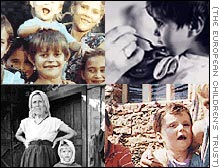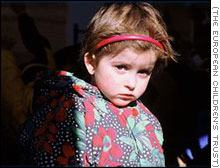|
|
|

| |
| "Time is running out -- they cannot continue living this way" | |
LONDON, England -- At least 50 million children in eastern Europe and the former Soviet Union live in poverty and are exposed to levels of tuberculosis usually associated with the Third World, a report says.
Overall, more than 160 million -- or 40 percent -- of the region's population are thought to live in poverty, says the European Children's Trust, a non-governmental body working in 10 eastern European countries.
It wants the West to help by easing debt burdens.
The report, called The Silent Crisis, says poverty in the region has increased more than ten-fold over the last decade due to cuts in government spending on health, education and social programmes.
"Time is running out," the Trust said. "That there has not been a total collapse of social structures in these countries so far is a testament to the resilience of the people there. But they cannot continue living this way indefinitely."
The report said: "Since the break-up of the communist system, conditions have become much worse -- in some cases catastrophically so.
"In view of the extent of the economic collapse ... the term 'transition' seems a euphemism. 'Great Depression' might be more appropriate.
"For all its many faults, the old system provided most people with a reasonable standard of living and a certain security," the report added.
Of the 50 million children in "genuine poverty," 40 million are in the former Soviet Union.
As indicators of poverty, the report measured infant mortality, the proportion of the population not expected to live to 60 and the number of tuberculosis cases.
It said the region's infant mortality -- 26 per 1,000 births in 1998 -- is approaching rates in Latin America and the Caribbean, where infant mortality is 32 per 1,000. In the U.S., the figure is 7.2.
Nearly a quarter of the region's population is not expected to reach 60 -- about the same as in Arab states. Russia was on a par with India, with nearly 30 percent not expected to reach 60.
Rates of tuberculosis -- a powerful measure of social deprivation -- were also much higher in eastern Europe, with an average 67.6 cases per 1,000 people in 1997. That compared with 49.6 in Arab states, 47.6 in Latin America and 35.1 in east Asia. For developing countries, the rate was 68.6.
Tuberculosis rates ranged from about 20 per 1,000 in the Czech Republic and Slovenia, to 80 per 1,000 in Lithuania, Turkmenistan, Latvia and Russia, and 150 per 1,000 in Georgia.
The Trust said maternity and child benefits, unemployment pay and pensions, free education and health care, affordable public transport and housing have all disappeared across eastern Europe as national incomes and public expenditure have plummeted.

| |
| Children face poor education and health services | |
The proportion of the population living below the poverty line was worst -- at 88 percent -- in Kyrgyzstan.
Poverty figures ranged from less than one percent in Slovenia, the Czech Republic and Slovakia, to four percent in Hungary, 20 percent in Poland, 50 percent in Russia to more than 60 percent in Turkmenistan, Ukraine, Kazakhstan and Moldova, the report said, citing data from the U.N. Development Program.
The Trust also called for help for services that prevent family breakdown. Aid should be focused on training, it said, rather than on short-term relief.
European Children's Trust
Note: Pages will open in a new browser windowExternal sites are not endorsed by CNN Interactive.